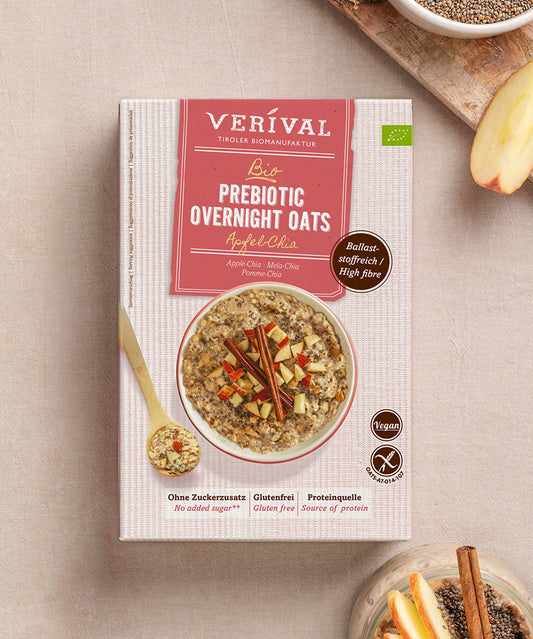When it comes to cholesterol, also known as blood lipids, there are a lot of terms you should know and understand. These include, in particular, LDL and HDL cholesterol.
In this article, we will tell you what LDL and HDL cholesterol mean, what causes elevated cholesterol levels and what risks they pose.
What is LDL cholesterol?
LDL cholesterol is a lipoprotein that plays a central role in the body's fat metabolism. Unlike high-density lipoprotein (HDL), LDL cholesterol transports fat molecules to cells, especially to cell membranes. This transport function is crucial for various biological processes.
Cell membranes are made of lipids, which include cholesterol. LDL cholesterol delivers this cholesterol to cells to ensure the structural integrity of membranes. In addition, LDL is involved in the regulation of fat metabolism, which is crucial for the energy production of cells.
Are you looking for healthy breakfast options? This way!
Difference between LDL and HDL cholesterol
Low-density lipoprotein and high-density lipoprotein are two main types of lipoproteins in the blood that play a crucial role in the body's fat metabolism.
LDL cholesterol
LDL cholesterol is often referred to as “bad” cholesterol. Its main function is to transport cholesterol from the liver to the cells where it is needed for the formation of cell membranes and various biological processes. However, if the concentration of LDL cholesterol in the blood is too high, it can cause deposits in the arterial walls, increasing the risk of atherosclerosis and cardiovascular disease.
HDL cholesterol
In contrast, HDL cholesterol is often referred to as “good” cholesterol. The main function of HDL is to transport excess cholesterol from cells and tissues back to the liver, where it is broken down and excreted. HDL thus acts as a cleaning agent in the blood, removing excess cholesterol from the circulation and helping to prevent hardening of the arteries.
Explanation of the functions of HDL and LDL cholesterol
LDL cholesterol functions
Cholesterol carrier to cells: LDL transports cholesterol to cells to ensure their structural integrity.
Involvement in fat metabolism: LDL is crucial for the cells' energy production by transporting fats.
HDL cholesterol functions
Removal of excess cholesterol: HDL transports excess cholesterol back to the liver for breakdown and excretion.
Protection against atherosclerosis: By cleaning the blood, HDL helps to prevent deposits in the arteries.
A healthy LDL/HDL ratio is crucial for a healthy lipid metabolism and a lower risk of cardiovascular disease. A sensible, low-cholesterol diet and a healthy lifestyle can help to maintain this balance and promote the positive functions of HDL.
The importance of LDL cholesterol levels
The LDL cholesterol value plays a central role in assessing the risk of cardiovascular disease. An accurate measurement of this blood lipid value enables doctors to recognize potential dangers early on and take appropriate preventive measures.
Risk assessment using LDL cholesterol
Elevated LDL cholesterol levels are directly associated with an increased risk of atherosclerosis and heart attacks. A differentiated view of LDL values makes it possible to categorize patients into risk groups and develop individual prevention strategies.
Setting target levels
Medical guidelines, such as those of the European Society of Cardiology (ESC), define clear target levels for LDL cholesterol levels. These target levels take into account individual risk factors such as diabetes mellitus, high blood pressure and smoking. Regular monitoring of LDL cholesterol levels is therefore essential to assess the effectiveness of preventive measures.
The link between LDL cholesterol and atherosclerosis
The significance of LDL cholesterol for arterial health is directly linked to the development of atherosclerosis.
Elevated levels of LDL cholesterol promote the formation of plaques in the arterial walls. LDL cholesterol can oxidize and deposit on the vessel walls, causing a gradual narrowing of the blood vessels. This process is known as atherosclerosis.
Arteriosclerosis significantly increases the risk of heart attacks and strokes. The buildup in the arteries can lead to blood clots blocking vital blood vessels and cause serious cardiovascular events.
The importance of LDL cholesterol as an indicator of an individual's cardiovascular risk underscores the need for proactive control and, if necessary, adjustment of lifestyle or drug therapy. Being aware of LDL levels not only enables early detection of problems, but also provides the basis for targeted and successful prevention of cardiovascular disease.
Risk factors for high LDL cholesterol levels
An elevated LDL cholesterol level can be due to a variety of factors, ranging from genetic predisposition to lifestyle habits. Knowledge of these risk factors is crucial to initiate targeted preventive measures.
Genetic factors play a significant role in the regulation of cholesterol metabolism. Individuals with familial hypercholesterolemia have a genetic tendency towards elevated LDL cholesterol levels. Early identification of such genetic predispositions enables targeted therapy and prevention.
Diet plays a key role in regulating LDL cholesterol levels. A high intake of saturated fatty acids, which are mainly found in animal products, can contribute to an increase in LDL cholesterol. Similarly, trans fats, which are found in many processed foods, can negatively affect LDL levels.
A sedentary lifestyle, accompanied by a lack of physical activity, contributes to the development of high LDL cholesterol levels. By contrast, regular physical exercise not only helps to control weight, but also reduces LDL cholesterol, thus helping to lower the risk.
A balanced diet with a focus on unsaturated fatty acids, omega-3 fatty acids from fish and fiber can help to regulate LDL cholesterol levels. Avoiding excessive consumption of saturated and trans fats is crucial to counteract an increased cholesterol intake.
Active lifestyle habits, including regular physical activity, have a positive influence on LDL cholesterol levels. Not smoking and moderate alcohol consumption also help to maintain healthy cholesterol levels.
People with a genetic predisposition should pay particular attention to a healthy lifestyle and have their cholesterol levels monitored regularly. In the case of familial hypercholesterolemia, early intervention, possibly even drug therapy, is necessary to minimize the risk of cardiovascular disease.
A holistic approach to these factors makes it possible to develop targeted preventive measures and implement individually adapted strategies for lowering LDL cholesterol levels. A conscious lifestyle, combined with genetic consideration, thus forms the basis for healthy cholesterol metabolism and sustainably reduces the risk of cardiovascular disease.
Discover the full range of Verival Müsli here
Effects of high LDL cholesterol
High LDL cholesterol levels can have a wide range of effects on health and significantly increase the risk of various secondary diseases.
One of the main consequences of high LDL cholesterol is the development of atherosclerosis. This is a progressive condition in which cholesterol and other substances are deposited in the arterial walls, leading to plaques. These plaques narrow the blood vessels and impair normal blood flow.
High LDL cholesterol poses a significant risk to the coronary arteries. The buildup in the arteries can cause them to narrow or even block, limiting blood flow to the heart. This condition increases the risk of angina, heart attack, and other serious cardiovascular events.
Another possible result of high LDL cholesterol is peripheral arterial disease, in which atherosclerosis narrows the arteries in the legs or other extremities. This can lead to pain when walking, ulcers and, in severe cases, even amputations.
High LDL cholesterol promotes the deposition of cholesterol in the arterial walls. These deposits can harden over time and trigger inflammation. This process increases the formation of plaques that narrow the vessels and impair their elasticity.
The plaques consist of cholesterol, fat, connective tissue and other substances. They form at sites where the arterial walls have been damaged by LDL cholesterol. These plaques can eventually rupture or thrombose, leading to life-threatening conditions such as heart attacks or strokes.
A clear understanding of the secondary diseases associated with high LDL cholesterol underlines the importance of controlling this risk factor. Preventive measures, including a healthy diet, regular exercise and, if necessary, medication, are crucial to minimize the risk of serious cardiovascular diseases.
Not all cholesterol is the same. There is “good” and “bad”!
Diagnosis of LDL cholesterol levels
Accurate measurement of LDL cholesterol levels is crucial for the diagnosis and management of cardiovascular disease. Different methods are used to determine the LDL cholesterol level precisely.
The most common method for determining LDL cholesterol levels is through a blood test. In this case, a sample of venous blood is taken and the cholesterol is analyzed. Modern laboratory techniques allow for a precise differentiation between LDL and other forms of cholesterol.
The direct measurement of LDL cholesterol refers to specific tests that exclusively quantify LDL cholesterol. This method is precise and direct, but may be more expensive than other methods.
The total blood cholesterol levels include not only LDL, but also other forms of cholesterol such as HDL and triglycerides. These values are crucial for a comprehensive assessment of cholesterol metabolism and serve as a basis for estimating an individual's risk of cardiovascular disease.
LDL cholesterol is a specific component of blood lipid levels and is often considered in relation to other cholesterol fractions. An optimal cholesterol level is characterized by low LDL and high HDL levels, which minimizes the risk of cardiovascular disease.
Total cholesterol reflects the sum of all cholesterol forms. Although it serves as a general indicator, it is important to also consider the individual levels of LDL and HDL in order to make a precise risk assessment.
Regular monitoring of these blood lipid levels enables early identification of changes in cholesterol metabolism. Accurate diagnostics lay the foundation for targeted treatment and prevention of cardiovascular disease.
Management and treatment of high LDL
Lowering LDL cholesterol can be achieved through a healthy diet, regular exercise and medication such as statins.
Statins are drugs that lower cholesterol. The decision on their use should be made on an individual basis, taking into account the overall risk of the patient.
The importance of a balanced diet low in saturated fat and regular exercise cannot be overstated. These measures help to prevent high LDL levels.
Regular physical activity and maintaining a healthy weight are crucial to keeping LDL cholesterol in check.
People with familial hypercholesterolemia have a genetic predisposition to high cholesterol levels. Treatment therefore requires a personalized approach.
Familial hypercholesterolemia is associated with a genetic defect that significantly increases LDL cholesterol levels. Early diagnosis and targeted treatment are crucial here.
Summary: LDL cholesterol
In this comprehensive article, we have looked at various aspects of LDL cholesterol. From the definition and significance of LDL cholesterol levels to diagnostic procedures and prevention.
It is crucial to have regular health checks, keep an eye on your LDL cholesterol level and minimize your risk of cardiovascular disease by adopting a healthy lifestyle. If necessary, individual advice should be sought from specialists such as cardiologists.
Discover Verival's sugar-free breakfast here!
Frequently asked questions
What exactly is LDL cholesterol and why is it important?
LDL cholesterol, or low density lipoprotein, is a lipoprotein that transports cholesterol in the blood. It is referred to as “bad” cholesterol because high levels of LDL can increase the risk of atherosclerosis and cardiovascular disease. It is important because a balanced amount of LDL cholesterol is necessary for the body, but an excess can lead to health issues.
How can you lower high LDL cholesterol?
Lowering high LDL cholesterol levels can be achieved through a healthy diet low in saturated and trans fats, regular physical activity, not smoking and, if necessary, through drug therapy such as statins.
What risk factors contribute to elevated LDL cholesterol?
Risk factors for elevated LDL cholesterol include genetic predisposition, unhealthy diet, lack of physical activity, smoking, obesity, diabetes mellitus and certain medications.
Can you control LDL cholesterol through diet alone?
Yes, a healthy diet plays a crucial role in controlling LDL cholesterol. Reducing saturated fat and trans fat, and increasing unsaturated fat and fiber in your diet can help maintain healthy cholesterol levels.
What is the difference between LDL and HDL cholesterol?
LDL cholesterol transports cholesterol from the liver to the cells and is considered “bad” cholesterol. HDL cholesterol, or high-density lipoprotein, transports excess cholesterol from the cells to the liver and is considered “good” cholesterol. A good balance between the two is important for cardiovascular health.
What health problems can arise from high LDL cholesterol?
High LDL cholesterol levels can lead to atherosclerosis, which in turn increases the risk of heart attacks, strokes, peripheral arterial disease and other cardiovascular diseases. It can also lead to health problems associated with the formation of plaques in the arterial walls.
























